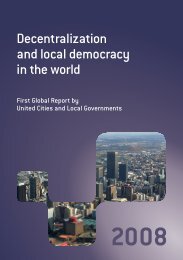Making Cities Resilient Report 2012
Making Cities Resilient Report 2012
Making Cities Resilient Report 2012
Create successful ePaper yourself
Turn your PDF publications into a flip-book with our unique Google optimized e-Paper software.
• Strengthened partnerships: The Campaign supports a participatory approach to resilience building<br />
that fosters dialogues between local governments, national authorities, legislators, civil society,<br />
private sector, professional associations and academia, who previously may have had limited<br />
interaction with each other. The Campaign currently counts on more than 40 global or regional<br />
organisation partners, which are supporting knowledge products, training or technical assistance to<br />
cities to build resilience. Many pilots, trainings and capacity building initiatives are associated with<br />
the Campaign and based on its tools. Donor agencies, including some of the European Commission<br />
Directorates, are making explicit use of the Campaign tools.<br />
3. Commitments to date can be strengthened and extended<br />
Despite the significant efforts underway by the cities documented in this report, much remains to be done<br />
to make disaster risk reduction a priority for many local governments.<br />
Increase the number of cities where commitments lead to action<br />
Approximately one billion urban dwellers today live in informal settlements, most of which lack the<br />
services and good quality buildings that are a key part of resilience. Most of the anticipated increase in<br />
the world’s population between now and 2030 will be in urban centres in Africa and Asia – and a large<br />
part of this will be in small and medium urban centres in these regions that lack basic infrastructure in<br />
general and services to cope with disasters.<br />
As the examples from Kenya and Tanzania show, many cities have signaled commitment but have yet to<br />
take action to address disaster risks. While competing priorities are often cited as constraining factors,<br />
increased support to establishing the enabling environment and promotion of innovation can unlock<br />
doors to progress. The factors outlined in this report provide guidance for increased support. Among<br />
these, showcasing local leadership in national and international forums can play an instrumental role in<br />
increasing the flow of political, technical and financial support for local action.<br />
Integrate disaster risk reduction into development planning processes<br />
and daily city operations<br />
Many aspects of the Ten Essentials are inextricably linked to development processes and decisions.<br />
Multiple benefits for both development and disaster resilience derive from investments in good governance<br />
and improvements in urban infrastructure, health and education, for instance.<br />
While the initiatives undertaken by many of cities reported here are significant, very few have systematically<br />
leveraged the instruments of development.<br />
Introducing measures such as risk screening into the planning and design of urban infrastructure, for<br />
instance, can save lives and extend the longevity of critical infrastructure. Having infrastructure that is<br />
fit for purpose and well maintained is part of disaster risk reduction and resilience, but it is also central<br />
to the smooth functioning of the city, its economy and people’s well being. Factoring risk into land use<br />
planning procedures can reduce exposure to natural hazards. Protecting schools and hospitals can hasten<br />
achievement of poverty reduction goals.<br />
78 | <strong>Making</strong> <strong>Cities</strong> <strong>Resilient</strong> <strong>Report</strong> <strong>2012</strong>

















